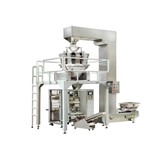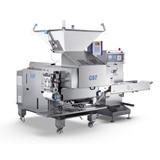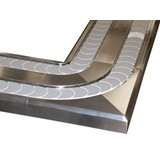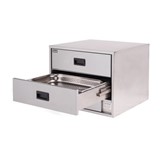Explore the top food and beverage trends shaping Australian restaurants in 2025—from AI-powered kitchens to functional drinks and zero-proof menus. Packed with local stats, actionable insights, and real-world examples to future-proof your venue.
Key Takeaways
- Plant-based innovation is expanding beyond burgers, with Australia's plant-based food market projected to reach $9 billion by 2030.
- Hyper-local sourcing is in demand, as 78% of Australians prefer food with local origins.
- AI and robotics are streamlining kitchens, with AI tools forecasted to save Australian restaurants up to 25% on labour by 2026.
- Functional foods and drinks, like mood-boosting sodas and gut-health elixirs, are growing by 12.5% year-on-year.
- No- and low-alcohol beverages are surging, with Australia's zero-alcohol beer market projected to grow by 31% by 2026.
- Menu innovation: Include plant-based dishes, adaptogenic drinks, native ingredients, zero-waste options, alcohol-free cocktails, and interactive formats to meet 2025 Australian dining trends.
- QR code and app-based ordering are now used by over 67% of Australian casual dining venues, reshaping the customer experience.
- Waste reduction and circular menus are key to sustainability, aligning with government targets to halve food waste by 2030.
Introduction: What's cooking in 2025?
Australia's restaurant scene is evolving rapidly. With shifting diner expectations, emerging technologies, and sustainability becoming a priority, staying ahead of food and beverage trends is essential. Whether you run a fine-dining venue in Sydney or a regional café in Ballarat, understanding the trends shaping 2025 will help you stay competitive.
Plant-based 2.0: Beyond the burger
Plant-based eating is no longer niche. Australians are embracing flexitarian lifestyles, and plant-based innovation is responding accordingly.
Key shifts to watch:
- Whole-ingredient focus: Less faux meat, more mushrooms, legumes, and jackfruit.
- Plant-based seafood: Offerings like seaweed-based prawns and konjac sashimi are gaining traction.
- Australian native ingredients: Quandong, wattleseed, and finger lime feature in next-gen vegan menus.
Stat Check: Over 32% of Australians are actively reducing meat consumption, and plant-based protein alternatives are projected to generate $9 billion locally by 2030.
Functional foods and adaptogenic beverages
Diners are not just eating for flavour, they're eating for focus, mood, gut health, and energy.
Trending inclusions:
- Adaptogens: Ingredients like ashwagandha and ginseng are appearing in smoothies, teas, and sauces.
- Gut-health tonics: Kombucha, water kefir, and prebiotic sodas with chicory or apple cider vinegar.
- Mood foods: Menus now feature magnesium-rich grains, turmeric, and dark leafy greens.
Stat Check: The functional food and beverage market in Australia is expected to grow by 12.5% year-on-year into 2025.
Hyper-local sourcing and foraging
Consumers increasingly want to know where their food comes from, and they're choosing venues that source locally or grow in-house.
Popular practices:
- Micro-farms and edible gardens on-site or nearby.
- First Nations produce as a core menu component.
- Seasonal, circular menus to cut transport emissions and food miles.
Stat Check: 78% of Australian consumers are more likely to trust a restaurant that sources locally.
Tech-powered dining: From kitchen to customer
Digital transformation is redefining how diners interact with your venue, and how you run it.
Key technologies trending:
- QR code and app ordering: Reducing waitstaff overheads and increasing order accuracy.
- Kitchen robotics: From robotic grillers to automated dishwashers, reducing labour costs.
- AI-driven inventory systems: Minimising waste and improving cash flow.
Stat Check: AI and automation are forecasted to cut restaurant labour costs by up to 25% in the next two years.
Sustainability on the plate
Diners care about more than taste, they want to know your restaurant is environmentally conscious. In 2025, sustainability is no longer a bonus; it's a baseline.
Key strategies:
- Circular menus: Using offcuts, upcycling ingredients, and rotating based on waste data.
- Carbon labelling: Showing the footprint of dishes.
- Minimalist packaging: Compostable, reusable, or zero-packaging where possible.
Stat Check: Australia has committed to halving food waste by 2030, a goal that will increasingly impact hospitality.
The rise of low- and no-alcohol menus
Australians are drinking less but not compromising on experience.
What's changing:
- Crafted non-alcoholic cocktails, not just mocktails.
- No- and low-alc beer, wine, and spirits featured on main menus.
- Functional and fermented drinks as bar staples.
Stat Check: Zero-alcohol beer sales are projected to grow by 31% by 2026 in Australia.
Flexible, fast, and experiential dining
The "sit-down meal" is evolving. Diners want customisation, convenience, and entertainment in one visit.
What this means for your restaurant:
- Flexible menus that work across dine-in, takeaway, and delivery.
- Experience-first formats like chef's tables, DIY tasting menus, and immersive themed nights.
- Speed-service models optimised through smart POS and menu engineering.
Stat Check: Over 67% of casual dining venues in Australia now use QR or app-based ordering systems.
Menu items your restaurant should offer in 2025
If you're looking to stay relevant and boost both margins and engagement, here’s a practical breakdown of menu items that align with each major 2025 trend. These aren't just buzzwords—they’re customer-driven preferences already shaping venues across Australia.
1. Plant-based 2.0
- Smoked jackfruit bao buns with chilli mayo and pickled slaw
- Charred king oyster mushroom skewers with wattleseed glaze
- Chickpea panisse fries with lemon myrtle aioli
- Kelp noodle salads with sesame-ginger dressing
2. Functional and adaptogenic beverages
- Ashwagandha hot cacao with oat milk and cinnamon
- Chicory root espresso tonic with orange peel
- Turmeric and ginger kombucha spritzers
- Ginseng-infused sparkling apple vinegar tonics
3. Hyper-local and seasonal sourcing
- Bush tomato focaccia with whipped ricotta and foraged herbs
- Native citrus ceviche with finger lime and saltbush
- Seasonal circular soup that changes weekly based on kitchen offcuts
- House-fermented vegetables with native spice blends
4. Sustainable, zero-waste options
- Cauliflower stem curry with tamarind and lentils
- Fish offcut tartare with crispy skin chips
- Reused bread pudding with spent coffee crème anglaise
- Cocktails with aquafaba foam instead of egg whites
5. Low- and no-alcohol drinks
- Zero-proof espresso martini using Lyre’s Coffee Originale
- Native spritz with Davidson plum syrup, soda and lemon myrtle
- Alcohol-free sour with verjuice, citrus, and vegan foamer
- Non-alc dark & stormy with spiced ginger beer and botanical bitters
6. Flexible and experiential formats
- DIY bao kits for dine-in and delivery
- Chef’s rotating tasting menu with 3 or 5-course options (seasonal and plant-led)
- Interactive dessert boards with dipping sauces and smoked elements
- QR-code activated wine or zero-proof tasting flights
Cost and ROI insights for trending upgrades
Before diving into trending innovations, it's worth understanding what they might cost, and what kind of return they could deliver. For many Australian restaurants, small investments in tech or menu innovation can lead to meaningful savings or revenue uplift.
Estimated costs and ROI ranges:
- QR-based ordering systems: Expect to invest $3,000–$10,000, with ROI typically seen in 3–6 months through labour savings and improved upselling.
- No-alcohol drinks menu starter kits: Setup costs generally range between $1,500–$3,500, offering immediate returns with healthy margins of 15–25%.
- Plant-based menu consulting: Hiring an expert or specialist team can cost between $2,000–$7,000, with ROI emerging within 6–12 months via new customer acquisition.
- AI inventory and ordering tools: These systems typically cost $5,000–$15,000, but can pay off within 4–8 months through waste reduction and better stock control.
- Fermentation or kombucha brewing setups: Equipment and starter ingredients may cost $2,500–$6,000, with ROI in 6–10 months via value-added drink sales.
Financing options to consider:
- Hospitality-focused equipment loans from alternative or non-bank lenders.
- Lease-to-own agreements that allow upgrades without major upfront capital.
- Government-backed programs such as the Energy Efficiency Grants or Digital Solutions for Small Business initiatives.
Tip: Investing in just one upgrade, such as self-service tech, can reduce FOH staff reliance by up to 22%, while improving order accuracy by 15%.
Staffing and training implications
As restaurant trends evolve, your team will need to evolve with them. From preparing functional foods to managing AI tools, staying competitive means investing in staff development.
What's changing for hospitality teams:
- Reduced FOH staffing requirements due to app-based ordering, but a growing need for staff who can manage customer experience and upselling.
- Upskilling for chefs and kitchen staff, especially in plant-based cooking, fermentation, and native ingredient integration.
- Emerging roles like sustainability coordinators, beverage curators, and technology facilitators.
Where to find relevant training in Australia:
- TAFE NSW and TAFE Queensland offer short courses in sustainable kitchen practices, plant-based culinary skills, and digital hospitality tools.
- Industry certifications from Restaurant & Catering Australia or the Australian Culinary Federation are increasingly valuable.
- Supplier-led training programs provided by brands focused on functional foods, plant-based products, or low-alcohol beverages.
Example: A Brisbane-based café chain trained all baristas in gut-health beverage prep in 2024 and saw a 19% uplift in kombucha and tonic sales per site.
Menu design and engineering tips
How you present your menu can make all the difference between a trend that excites customers, and one that gets overlooked. Thoughtful menu design not only showcases your new offerings but also helps maximise your revenue and enhances the overall dining experience.
- Group thoughtfully: Avoid lumping functional and low-alcohol beverages under “soft drinks” or “non-alcoholic” categories, which can feel low-value or generic. Instead, create a dedicated section with appealing names like “Zero-proof cocktails,” “Mindful mixology,” or “Functional beverages.” This signals to customers that these drinks are crafted and premium, encouraging higher spend.
- Use clear icons and descriptors: Help diners quickly identify drinks that align with their preferences by adding simple icons or brief descriptors.
- Leverage price anchoring: Strategically price your new trend items to maximise margins. Place a standout premium option next to mid-range drinks to encourage upsells.
- For example, a $16 zero-proof cocktail next to a $12 kombucha can make the kombucha seem like great value, while still increasing your average spend.
- Equip staff with suggestive selling tips: Train your team to confidently recommend alcohol-free or functional options as natural pairings or alternatives. Simple prompts work well, such as:
- “Would you like to pair that with our refreshing 0% sparkling kombucha?”
- “Our mood-boosting tonic is perfect if you want something light and energising.”
By applying these menu design and engineering strategies, you’ll ensure your food and beverage trends don’t just look good on paper, they become a profitable part of your business.
Compliance and regulatory considerations
Staying compliant with Australian food, tech, and labelling laws is critical when adopting new trends, especially those that touch health, sustainability, or customer data.
Key compliance areas for 2025:
- Labelling and Claims:
- Ensure health or functional claims (e.g., "boosts mood") follow FSANZ guidelines.
- Use caution when promoting native ingredients, some require cultural consultation and food safety approvals.
- Alcohol-free beverages with 0.5% ABV or less must still comply with state liquor laws.
- Sustainability Claims:
- The ACCC is cracking down on greenwashing, only promote compostable packaging or carbon offsets if independently verified.
- Look for trusted certifications like Australian Certified Organic or Climate Active.
- Data Privacy in Digital Ordering:
- Restaurants using QR codes, apps, or loyalty platforms must comply with the Privacy Act 1988.
- Disclose how customer data is stored, used, and protected.
Stat Check: In a 2024 sweep, 28% of hospitality venues reviewed by the ACCC were found to have made potentially misleading environmental or health-related claims.
Final thoughts: Where to go from here?
Staying competitive in 2025 doesn’t mean overhauling your entire operation overnight. It means identifying the shifts that matter most to your customers, health, sustainability, personalisation, and tech-enabled convenience, and taking deliberate steps to meet them.
Start small. Introduce a plant-based special with native ingredients. Trial a low-alcohol cocktail flight. Optimise your kitchen’s inventory with AI tools. These changes don’t just follow trends, they help you lead in areas that directly impact profitability, loyalty, and brand perception.
The venues succeeding this year aren’t the flashiest—they’re the ones listening to what diners care about and responding with clarity, authenticity, and agility. If you can do that, you’re not just riding the trends. You’re setting them.


-160x160-state_article-rel-cat.png)


-160x160-state_article-rel-cat.png)






-160x160-state_article-rel-cat.png)







